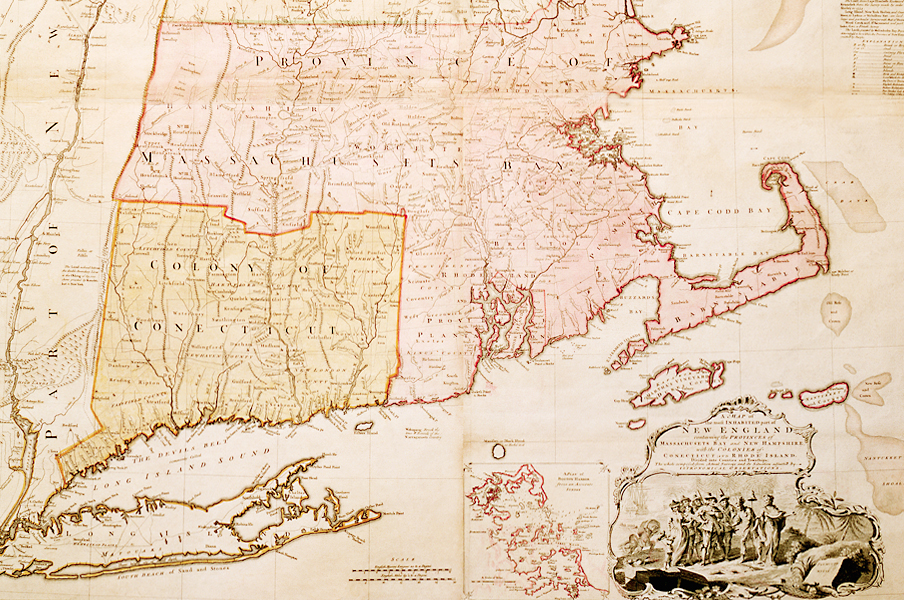New England Connection: The East End Was Once Part of Connecticut

Everyone who comes to eastern Long Island is struck by the fact that the dozen or so major towns here look exactly like old New England villages. They have village greens, village ponds, windmills, saltbox houses, main streets, white churches with tall steeples. How could this be? This is Long Island. There are no old English towns on Long Island. But at the very east end of the island, there are, and they are all clustered together.
The fact is that when the East End villages were first built, they WERE New England towns. The Dutch were in Nieuw Amsterdam. But out east, English subjects from New England had come across Long Island Sound soon after the Dutch established Nieuw Amsterdam, and established themselves at this place. And they never left. Southold, Southampton, East Hampton and Bridgehampton were settled at a time (1640, 1640, 1648 and 1656 respectively) when there was no city named New York. All except Southampton were founded by the settlers from Connecticut. Southampton’s settlers came from Lynn, Massachusetts.
The elders here met periodically in log cabin long houses to administer the communities. But because settlers from Holland were to their west in Brooklyn and Manhattan, there seemed to be a necessity to adopt laws of one of the larger English colonies across the water. There were five: Massachusetts, Plymouth, Rhode Island, New Haven and Connecticut. New Haven, you say? Yup. A man named John Davenport had founded New Haven Colony two years before the villages on Long Island were founded. Davenport felt the settlers in Massachusetts and Connecticut were not religious enough. So he and his followers founded New Haven Colony in 1638, separate from Connecticut. In any case, the East End settlers met. They chose, in 1664, to become part of Connecticut. Those in Southampton might have disagreed, since they were from Massachusetts, but they went along with it.
In 1658, several decades before New England went crazy and began murdering women they considered witches in Salem and other places, the people of East Hampton, churchgoing Puritans all, became terrified that one of their own was a witch. Her name was Goody Garlick and she was, by all accounts then, a mean, gossipy woman with low opinions of her neighbors. She was in her 50s when the accusations came, married to a man who worked for Lion Gardiner, the founder of the town. It was said she could make animals do her bidding and could cast spells. One day, 16-year-old Elizabeth Gardiner Howell, the newly married daughter of Lion Gardiner, became sick. She got worse, took to her bed, and became delirious. In her delirium, she said she saw Goody Garlick at the foot of her bed, casting a spell on her; then this young woman got worse, and the next day she died.
The townspeople wanted Goody Garlick put to death before she killed more. A board of inquiry was formed, where magistrates heard testimony from townspeople. But it was determined that the people of East Hampton did not have the learning or skill to judge such a matter; Goody Garlick would be moved to be put on trial in the colonial court in Hartford, Connecticut.
That court found her not guilty, and ordered her released and brought back to East Hampton. The Garlicks lived the rest of their lives there without further incident.
During this time, strange things were happening in Connecticut that came to involve eastern Long Island.
The colony of Connecticut was founded by Thomas Hooker in 1636. In 1640, a member of the Connecticut government, John Winthrop the Younger, gave a petition to the Governor of Connecticut that he wanted to have Fisher’s Island—land a few miles off the coast of Mystic in Connecticut—as his own private farming and hunting preserve. John Winthrop’s father had been the founder of Boston. He had a lot of clout. The Governor of Connecticut approved the request and, for good measure, the young John Winthrop made the exact same application to the Governor of Massachusetts, who also approved it. Things went along swimmingly for a while. John Winthrop the Younger visited his island. He was elected Governor of Connecticut.
Then, two years after Connecticut absorbed New Haven Colony, in 1662—New Haven opposed this for a while, then conceded—a momentous event for the colony occurred. In 1664, the British captured Nieuw Amsterdam and it was renamed New York after the Duke of York, brother of King Charles II. It was time for New York to stand up on its own.
As part of this undertaking, the King decreed various borders—we all know what they are— and also allowed that “all islands in Long Island Sound be part of New York, not Connecticut.” As a result, Plum Island off the coast of Orient Point became part of New York. So did Fisher’s Island, which was little more than a stone’s throw from Mystic. Needless to say, retired Governor John Winthrop the Younger had great objections to this. Rhode Island stirred as well. And so it was that a meeting soon took place among these three colonies, and it was confirmed that an island that should be part of Connecticut was nevertheless now part of New York. And so it is today.
Interestingly, the farmers and fishermen on eastern Long Island did not take kindly to the Duke of York’s decree, either. They at first, in 1664, refused to acknowledge they were part of New York. Well, what was New York supposed to do, invade? The East End was a place far, far away. In the end, New York waited it out. Finally, 12 years later, in 1676, the East Enders grudgingly went along with it. And so in spite of ourselves, that is where we are today.
Another fascinating story involving Connecticut and eastern Long Island took place in 1839. A slave ship in distress appeared offshore of Montauk. The ship, the Amistad, had originally come from Africa, where Spanish slavers had rounded up 53 Africans in chains in what is now Sierra Leone, led them to the ship, packed them into the hold, and took them to Havana, Cuba. From there, they were being transported to a smaller coastal city to be sold at auction when one slave, Cinque, broke free and, at night with several others, took over the ship. They killed all the Spaniards but two—a navigator and a man who could speak their African language and interpret. The Africans ordered them to sail them back home to Africa.
Instead, the Spaniards decided to pretend to do that. By day they headed east toward Africa, but at night, they turned the ship 90 degrees and headed North—the Africans knew nothing about celestial navigation—and eventually, zigzagging like this, made landfall
at Montauk.
Cinque and a party of Africans came ashore with one of their captives, and it was here, while talking to some East Hampton residents, that an American Revenue Cutter called the USS Washington came around Montauk Point, discovered the ship at Culloden Point, seized control of it and detained Cinque and his men.
They could have taken the men and the ship at this point to New York City. But the choice was made to take them to New London, Connecticut. Why? The captain of the Washington, Thomas R. Gedney, wanted to take personal possession of the ship and its cargo for salvage. This could be done with abandoned ships at sea at that time. Connecticut, in 1839, 22 years before the Civil War, had declared slavery illegal. New York had not. Therefore, if the ship were brought to New York City, the Spanish government would seize it. In Connecticut, it could be declared salvage under international law and given to Gedney.
In the end, Cinque and his men were put on trial in Hartford for mutiny and murder. The court acquitted them and ruled that as free men that could do whatever was necessary to free themselves from their kidnappers. The court ordered the Africans, free men, be transported home. But the Spanish, angry at these unfolding events, pressured President Martin Van Buren to appeal the decision to the Supreme Court.
It took a year before that case could get to the Supreme Court. During that time, the Africans were obliged to stay, but not be in jail, so they set up their encampment on the Hartford Town Green, where they sang and played instruments and were given food and clothing and visited by sympathizers and supporters.
Retired president John Quincy Adams stepped forward to defend the Africans before the court, and, in the end, the court ruled in their favor. Now they were truly free to go. Many stayed, but Cinque asked to go home, which he did aboard an American ship. He went happily ashore, and that was the last we know of him.
As you also may know, this encounter was made into a movie called Amistad, which many feel is among East Hampton resident Steven Spielberg’s best works.



